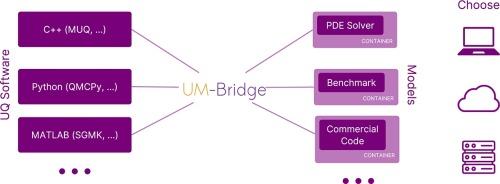Democratizing uncertainty quantification
IF 3.8
2区 物理与天体物理
Q2 COMPUTER SCIENCE, INTERDISCIPLINARY APPLICATIONS
引用次数: 0
Abstract
Uncertainty Quantification (UQ) is vital to safety-critical model-based analyses, but the widespread adoption of sophisticated UQ methods is limited by technical complexity. In this paper, we introduce UM-Bridge (the UQ and Modeling Bridge), a high-level abstraction and software protocol that facilitates universal interoperability of UQ software with simulation codes. It breaks down the technical complexity of advanced UQ applications and enables separation of concerns between experts. UM-Bridge democratizes UQ by allowing effective interdisciplinary collaboration, accelerating the development of advanced UQ methods, and making it easy to perform UQ analyses from prototype to High Performance Computing (HPC) scale.
In addition, we present a library of ready-to-run UQ benchmark problems, all easily accessible through UM-Bridge. These benchmarks support UQ methodology research, enabling reproducible performance comparisons. We demonstrate UM-Bridge with several scientific applications, harnessing HPC resources even using UQ codes not designed with HPC support.

不确定性量化民主化
不确定性量化(UQ)对基于模型的安全关键分析至关重要,但复杂的 UQ 方法的广泛采用受到技术复杂性的限制。本文介绍了 UM-Bridge(UQ 与建模桥),这是一种高级抽象和软件协议,可促进 UQ 软件与仿真代码的通用互操作性。它打破了高级 UQ 应用程序的技术复杂性,实现了专家之间的分工。UM-Bridge 允许进行有效的跨学科合作,加快了高级 UQ 方法的开发,并使从原型到高性能计算(HPC)规模的 UQ 分析都能轻松执行,从而实现了 UQ 的民主化。这些基准支持 UQ 方法研究,实现了可重复的性能比较。我们用几种科学应用演示了 UM-Bridge,即使使用不支持 HPC 的 UQ 代码,也能利用 HPC 资源。
本文章由计算机程序翻译,如有差异,请以英文原文为准。
求助全文
约1分钟内获得全文
求助全文
来源期刊

Journal of Computational Physics
物理-计算机:跨学科应用
CiteScore
7.60
自引率
14.60%
发文量
763
审稿时长
5.8 months
期刊介绍:
Journal of Computational Physics thoroughly treats the computational aspects of physical problems, presenting techniques for the numerical solution of mathematical equations arising in all areas of physics. The journal seeks to emphasize methods that cross disciplinary boundaries.
The Journal of Computational Physics also publishes short notes of 4 pages or less (including figures, tables, and references but excluding title pages). Letters to the Editor commenting on articles already published in this Journal will also be considered. Neither notes nor letters should have an abstract.
 求助内容:
求助内容: 应助结果提醒方式:
应助结果提醒方式:


